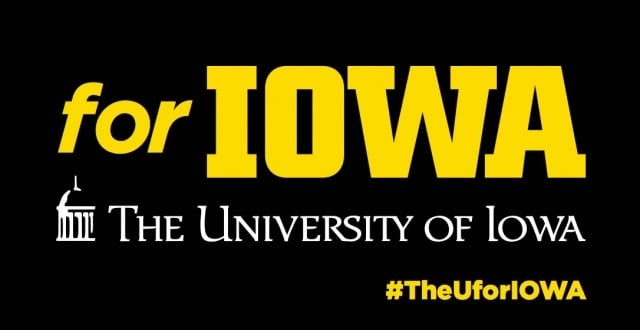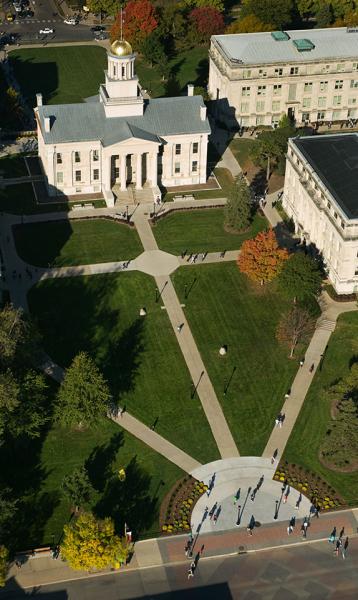You have /5 articles left.
Sign up for a free account or log in.

The University of Iowa launched a big marketing campaign and recruitment effort to recruit more Iowans, a grab for students that worries some other colleges in the state.
The University of Iowa.
Some private colleges in Iowa worry they could end up having to shut down because of an aggressive effort by the University of Iowa to enroll more students from within the state.
The state Board of Regents backed a funding plan earlier this year to encourage its three public universities to enroll more Iowans. The plan could cost the University of Iowa up to $60 million over the next several years if the cosmopolitan university doesn’t dramatically increase the number of Iowans on its campus.
Discussion on "This Week" of the In-State / Out-of-State Balance
Jerome A. “Jerry” Lucido, executive director of the University of Southern California Center for Enrollment Research, Policy, and Practice, will discuss tensions over out-of-state admissions on "This Week," Inside Higher Ed's free weekly news podcast, on Friday. To be notified of new editions of "This Week," sign up here.
About 14,000 of the University of Iowa’s 30,000 students are from other states and abroad – and that has drawn criticism from some within the state. The university enrolls 3,200 fewer Iowans than it did three decades ago.
So, when the Board of Regents decided to revamp how it distributes money, it put a huge emphasis on in-state student headcount. In order to avoid losing millions of dollars because of the new formula, the University of Iowa is blitzing the state with a heavy marketing and recruitment effort for next fall’s class.
In addition to the hundreds of thousands of dollars it is spending on the ad campaign, the university is also offering some students generous financial aid packages, anecdotes suggest.
The additional Iowan students have to come from somewhere, and private college presidents worry that the University of Iowa will try to save itself at their expense.
“If it results in a dramatic decline in Iowa students choosing private colleges, it could make it difficult for some to remain open,” said David McInally, the president of Coe College, in Cedar Rapids.
About 60 percent of the college’s 1,438 students come from outside Iowa. McInally said that gives Coe some cushion against enrollment shifts among Iowans. Other private colleges are far more dependent on Iowa students to fill their classrooms and dorms. In Iowa and elsewhere, most private colleges don't have truly national bases to recruit students, and they depend on a home-state advantage.
Community colleges, too, are worried.
“I can see this dramatically affecting what I call the balance of power,” said Mick Starcevich, the president of Kirkwood Community College.
The 15,000-student community college had a 17 percent enrollment decline this summer, Starcevich said. He blamed some – but not all – of that decline on the University of Iowa, which offered free summer tuition to its students who had successfully completed 20 credit hours or more in the past year.
Kirkwood, which works closely with the University of Iowa and even rents space on the university’s campus, might have enrolled those University of Iowa students hoping to pick up inexpensive credits.
If the University of Iowa gobbles up other colleges’ students, disturbs the balance of power and even sends some private colleges into bankruptcy, well that’s just tough – or so seemed to be the attitude of Iowa Board of Regents executive director Bob Donley.
“It’s an artificial balance – it’s the first time I’ve even heard the term used,” Donley said. “All of higher education has been transforming, so I’m not sure where they’ve been over the last few years. So we’re all having these moments where we have to stop and think about what we’re doing, what is our core mission and how are we going to be able to sustain ourselves over the next few years?”
He noted the poor graduate rates of community colleges versus four-year institutions and said there needs to be more competition.
A spokesman for the University of Iowa declined to comment and referred questions to the Board of Regents.
But the University of Iowa may be undertaking its in-state recruitment effort only reluctantly and because of the money at stake. Iowa, a university with a high national profile, may not want to be forced to change what works for it – and what works for it has involved bringing in a lot of top talent from out of state and beyond (about 12 percent of the university's students are from abroad).
Some of the university's supporters have quietly been trying to nix the regents’ plan. They have a chance: the legislature alone has the power to allocate the money, and it has not yet adopted the regents’ funding model.
“Legislators and supporters of the University of Iowa have called me,” said Gary Steinke, president of the Iowa Private College Association. He said they tell him, “It’s going to kill you guys; you should be lobbying against it.”
Steinke said he wants no part of that effort.
“How I feel particularly about how the regents want to fund the public universities, it just doesn’t matter; it’s none of our business,” he said.
Others, like Starcevich, may not be so reluctant to weigh in.
“I just hope that the legislature takes a hard look at it, and from my personal prospective, determines this not something they want to support,” he said.
McInally, the Coe president, thinks the regents’ plan will have numerous unintended consequences and will disrupt what he also called the balance of higher education in Iowa.
“I’m not suggesting that competition is bad, but just that there is some risk of disrupting the balance and not necessarily for education purposes,” he said.
The regents also oversee Iowa State University and the University of Northern Iowa. About 40 percent of Iowa State students and about 10 percent of Northern Iowa students are not from Iowa.
If in-state students flock to the University of Iowa and private colleges do suffer, that could have even wider consequences. Some private colleges -- including some, like Iowa Wesleyan, that have been struggling -- are the largest employers in their towns. That is among the concerns that private college presidents might take to their legislators.
Critics of the funding plan wonder if it might end up costing much more than planned. The argument goes like this: First, Iowa has been using out-of-state students to subsidize its operations. So, if it has more in-state students, which it may even lose money educating, then it will need more money from the state.
Second, if the university grows dramatically, then it may need to build new dorms and buildings, which the state would also be asked to pay for.
Third, if a private college were to close, its students would need to be educated somewhere. While the state does offer a scholarship to talented students who attend in-state private colleges, it would be far more expensive if all those private college students had to be educated at public institutions.
McInally said he isn’t sure how it benefits the state to focus so much on state residents, particularly since many public colleges – including the University of Iowa – have come to rely on the higher prices they charge out-of-state students. And the university, a major research institution, also thrives in part because of the talent it recruits from abroad.
“I don’t think giving them an incentive to reduce that international presence is necessarily in the best interest of the state,” he said.
Pamela Horne, the vice president for enrollment at Purdue University, another major Midwestern research university, said Iowa has placed itself in a “zero-sum situation.” Already, only 11 percent of Iowans who attend college go outside the state.
“So it’s quite possible that the high school students in Iowa will feel more wanted and special during the recruitment short term – but will the funding formula actually make a difference in the number of [high school] graduates who stay in the state?,” she said in an email. “Will it make a difference in the number who persist and complete degrees? And ultimately, will more of those who do graduate stay in Iowa for their careers? These questions and their outcomes may be the more fundamental for the state than which institutions can out-recruit one another.”
Tensions have flared at other major public universities over the number of out-of-state students they admit. The University of California system -- particularly its Berkeley campus -- has dealt with this issue recently. Officials in California argue that enrolling more out-of-state students has become necessary because of the higher tuition revenue the students bring. The University of California System plans to review its recent push to admit more out-of-state applicants, the Associated Press reported. Janet Napolitano, president of the university system, told the AP, "There are enough people that are concerned about it and have expressed that concern to me -- and I've seen it myself by looking at the numbers -- that it deserves a serious look, and we are giving it that." Thirty percent of those offered admission this year came from outside California, a sharp increase from historical levels.
Donley, the head of the Iowa regents, said there are about 300,000 Iowans in the state who have some university credits but who never finished. Part of the competition, he said, will be for those students.
In terms of traditional-age students, the demographics have been working against colleges, although the number of graduates is supposed to increase gradually in the next few years.
There are some questions about the business model that the University of Iowa is adopting.
Kevin Crockett is president and CEO of Noel-Levitz, a consulting firm that helps colleges recruit students, including some in Iowa. He expects the funding formula to force the University of Iowa to become “irrational” as it seeks to lure students by offering generous financial aid packages.
“What it’s going to lead to is probably irrational net pricing by the publics in pursuit of the state funds, so discounting deeper than they ordinarily do or should,” he said.
Basically, the University of Iowa can spend millions to attract students in order to hang on to the millions it stands to lose.
Starcevich, the community college president, said he’s already lost three students to the University of Iowa even though he'd offered them $5,000 scholarships -- enough to cover their full tuition at Kirkwood. So, he speculated, the university must have offered them more to make it worth the students’ while.
David Maxwell, the president of Drake University, said private college presidents are apprehensive about the University of Iowa’s plans, and he in particular worries that the university’s heavy discounting will cause students to enroll at Iowa who would have done better somewhere else.
“I think it’s going to put students and their families in an interesting position,” Maxwell said.




